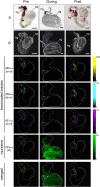Mass spectrometry imaging reveals new biological roles for choline esters and Tyrian purple precursors in muricid molluscs
- PMID: 26324173
- PMCID: PMC4555103
- DOI: 10.1038/srep13408
Mass spectrometry imaging reveals new biological roles for choline esters and Tyrian purple precursors in muricid molluscs
Abstract
Despite significant advances in chemical ecology, the biodistribution, temporal changes and ecological function of most marine secondary metabolites remain unknown. One such example is the association between choline esters and Tyrian purple precursors in muricid molluscs. Mass spectrometry imaging (MSI) on nano-structured surfaces has emerged as a sophisticated platform for spatial analysis of low molecular mass metabolites in heterogeneous tissues, ideal for low abundant secondary metabolites. Here we applied desorption-ionisation on porous silicon (DIOS) to examine in situ changes in biodistribution over the reproductive cycle. DIOS-MSI showed muscle-relaxing choline ester murexine to co-localise with tyrindoxyl sulfate in the biosynthetic hypobranchial glands. But during egg-laying, murexine was transferred to the capsule gland, and then to the egg capsules, where chemical ripening resulted in Tyrian purple formation. Murexine was found to tranquilise the larvae and may relax the reproductive tract. This study shows that DIOS-MSI is a powerful tool that can provide new insights into marine chemo-ecology.
Figures






Similar articles
-
Extraction and Quantification of Bioactive Tyrian Purple Precursors: A Comparative and Validation Study from the Hypobranchial Gland of a Muricid Dicathais orbita.Molecules. 2016 Dec 5;21(12):1672. doi: 10.3390/molecules21121672. Molecules. 2016. PMID: 27929402 Free PMC article.
-
Mass spectrometry imaging on porous silicon: investigating the distribution of bioactives in marine mollusc tissues.Anal Chem. 2012 Nov 6;84(21):8996-9001. doi: 10.1021/ac3027433. Epub 2012 Oct 8. Anal Chem. 2012. PMID: 23009618
-
Solvent separating secondary metabolites directly from biosynthetic tissue for surface-assisted laser desorption ionisation mass spectrometry.Mar Drugs. 2015 Mar 16;13(3):1410-31. doi: 10.3390/md13031410. Mar Drugs. 2015. PMID: 25786067 Free PMC article.
-
Natural product research in the Australian marine invertebrate Dicathais orbita.Mar Drugs. 2013 Apr 23;11(4):1370-98. doi: 10.3390/md11041370. Mar Drugs. 2013. PMID: 23612370 Free PMC article. Review.
-
Surface-assisted laser desorption ionization mass spectrometry techniques for application in forensics.Mass Spectrom Rev. 2015 Nov-Dec;34(6):627-40. doi: 10.1002/mas.21431. Epub 2014 Jun 11. Mass Spectrom Rev. 2015. PMID: 24916100 Review.
Cited by
-
Non-Peptidic Small Molecule Components from Cone Snail Venoms.Front Pharmacol. 2021 May 13;12:655981. doi: 10.3389/fphar.2021.655981. eCollection 2021. Front Pharmacol. 2021. PMID: 34054536 Free PMC article. Review.
-
Characterization of Bacterial Communities Associated with the Tyrian Purple Producing Gland in a Marine Gastropod.PLoS One. 2015 Oct 21;10(10):e0140725. doi: 10.1371/journal.pone.0140725. eCollection 2015. PLoS One. 2015. PMID: 26488885 Free PMC article.
-
Surface-assisted laser desorption/ionization mass spectrometry imaging: A review.Mass Spectrom Rev. 2022 May;41(3):373-420. doi: 10.1002/mas.21670. Epub 2020 Nov 10. Mass Spectrom Rev. 2022. PMID: 33174287 Free PMC article. Review.
-
Extraction and Quantification of Bioactive Tyrian Purple Precursors: A Comparative and Validation Study from the Hypobranchial Gland of a Muricid Dicathais orbita.Molecules. 2016 Dec 5;21(12):1672. doi: 10.3390/molecules21121672. Molecules. 2016. PMID: 27929402 Free PMC article.
-
Organic matrix-free imaging mass spectrometry.BMB Rep. 2020 Jul;53(7):349-356. doi: 10.5483/BMBRep.2020.53.7.078. BMB Rep. 2020. PMID: 32580835 Free PMC article. Review.
References
-
- Hay M. E. Marine chemical ecology: What’s known and what’s next? J Exp Mar Biol Ecol 200, 103–134 (1996).
-
- Cummins S. F. et al. Characterization of Aplysia enticin and temptin, two novel water-borne protein pheromones that act in concert with attractin to stimulate mate attraction. J Biol Chem 279, 25614–25622 (2004). - PubMed
-
- Cimino G., Passeggio A., Sodano G., Spinella A. & Villani G. Alarm pheromones from the Mediterranean opisthobranch Haminoea navicula. Experientia 47, 61–63 (1991).
-
- Kelley W. P. et al. Characterization of a novel gastropod toxin (6-Bromo-2-mercaptotryptamine) that inhibits shaker K channel activity. J Biol Chem 278, 34934–34942 (2003). - PubMed
-
- Olivera B. M. et al. Diversity of Conus neuropeptides. Science 249, 257–263 (1990). - PubMed
Publication types
MeSH terms
Substances
LinkOut - more resources
Full Text Sources
Other Literature Sources

